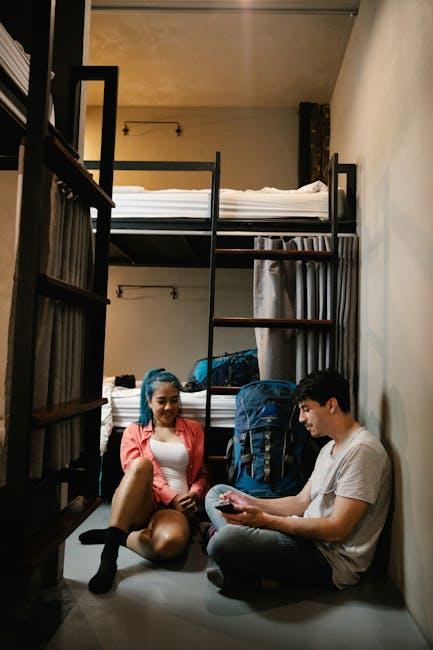In an era where the world is quite literally at our fingertips, the allure of exploring new cities, cultures, and landscapes without being tethered to a single desk has captured the imagination of countless digital nomads. Yet, the freedom of location comes with its own set of challenges—chief among them, managing finances smartly to stretch every dollar while maintaining a comfortable lifestyle on the road. Welcome to the art of smart spending: a savvy approach to budget travel that empowers digital nomads to navigate new horizons without breaking the bank. This guide will unveil practical tips and insightful strategies to make every journey not only enriching but also economically sustainable, proving that with a little planning and creativity, the world is open to those who travel wisely.
Table of Contents
- Finding Affordable Accommodation Without Sacrificing Comfort
- Maximizing Connectivity on a Budget for Seamless Remote Work
- Smart Food Choices to Save Money and Stay Healthy
- Utilizing Local Resources and Services to Stretch Your Travel Funds
- In Conclusion

Finding Affordable Accommodation Without Sacrificing Comfort
Securing a cozy and affordable place to stay doesn’t mean you have to compromise on the comforts that make a location feel like home. Start by exploring lesser-known neighborhoods or suburbs where prices tend to dip but amenities remain intact. Prioritize accommodations that include essentials such as reliable Wi-Fi, comfortable bedding, and a functional workspace—these small features can elevate your remote work experience significantly. Platforms offering monthly rentals or long-stay discounts can shrink your overall lodging expenses while ensuring a stable environment. Additionally, connecting with local communities online can unlock hidden gems like homestays or shared apartments where you get both affordability and authenticity.
Consider creating a checklist of your non-negotiables to filter out options that don’t meet your standards, so time isn’t wasted browsing unsuitable listings. When hunting for bargains, try negotiating directly with hosts for extended stays or off-peak discounts; many are willing to accommodate digital nomads’ flexible schedules. Below is a quick comparison of typical accommodation types favored by budget travelers, highlighting what to expect in comfort and cost:
| Accommodation Type | Average Monthly Cost | Comfort Level | Best For |
|---|---|---|---|
| Shared Apartment | $400 – $600 | Moderate | Social & budget-conscious nomads |
| Private Studio | $700 – $1000 | High | Professionals needing privacy |
| Guesthouse | $300 – $500 | Basic | Explorers seeking local flavor |

Maximizing Connectivity on a Budget for Seamless Remote Work
In the world of digital nomadism, staying connected is non-negotiable, but it doesn’t have to drain your wallet. Start by investing in a reliable portable Wi-Fi device or a local SIM card with generous data packages instead of expensive roaming plans. Prioritize destinations known for affordable and fast internet access — coworking hubs and cafés often offer not only a strong connection but also networking opportunities. Always test a connection before settling in, and keep a backup plan like offline work tools ready to avoid costly setbacks.
Consider these budget-friendly connectivity hacks:
- Utilize community Wi-Fi: Libraries and public parks frequently have free access.
- Leverage local deals: Check prepaid data options from smaller carriers.
- Optimize your device settings: Use data-saving modes and eliminate background syncing.
- Co-locate with other creatives: Sharing a workspace can cut internet costs substantially.
| Connectivity Method | Average Cost | Ideal For |
|---|---|---|
| Portable Wi-Fi Hotspot | $5 – $15/day | Frequent travel across countries |
| Local SIM Card | $10 – $30/month | Extended stays in one location |
| Coworking Space Membership | $50 – $150/month | Reliable, stable work environment |
| Public Wi-Fi Access | Free | Short-term, casual connectivity |

Smart Food Choices to Save Money and Stay Healthy
Prioritizing nutrition while on a budget doesn’t mean sacrificing flavor or health. Opt for locally sourced ingredients such as fresh fruits, vegetables, and grains found at markets or street vendors. These options are typically cheaper and fresher than imported goods, plus they offer a taste of the local culture. Preparing meals in your accommodation instead of dining out frequently can save a significant amount of money and give you control over your dietary choices. Consider stocking up on staples like rice, beans, and eggs, which are versatile, nutritious, and inexpensive.
To make smart food decisions, mastering the art of simple meal planning is essential. Stay ahead by creating a flexible grocery list focused on affordable superfoods and items that store well during your travels. Here’s a quick comparison of budget-friendly, nutrient-dense foods to keep handy:
| Food Item | Cost | Health Benefits | Storage |
|---|---|---|---|
| Oats | Low | High fiber, satiety | Long shelf life |
| Bananas | Low | Potassium, quick energy | Short term |
| Eggs | Moderate | Protein, vitamins | Refrigerated |
| Rice | Low | Energy, versatile | Long shelf life |
- Buy in bulk to reduce unit costs.
- Embrace seasonal produce for the best prices and freshness.
- Combine flavors with herbs and spices purchased locally.

Utilizing Local Resources and Services to Stretch Your Travel Funds
Embracing local resources is a game-changer for digital nomads aiming to maximize their budgets. Instead of defaulting to expensive international brands or tourist-centric services, seek out neighborhood markets, community events, and locally-run businesses. Street food stalls often serve authentic meals at a fraction of restaurant prices, and local transport can be both economical and an immersive experience. Moreover, tapping into co-working spaces tailored for residents rather than tourists often comes with better rates and networking opportunities that can lead to unique collaborations or insider tips.
Knowing where to find free or low-cost amenities helps you balance productivity with leisure without breaking the bank. Many cities offer public libraries with fast Wi-Fi, parks equipped with outdoor gyms, and cultural centers hosting free workshops or meetups. To stay organized and keep your expenses transparent, consider this quick guide to local spending options:
| Resource | Benefit | Example Usage |
|---|---|---|
| Local Markets | Affordable groceries & crafts | Buying fresh produce to cook meals |
| Public Transport | Cost-effective & authentic travel | Using buses or metro cards instead of taxis |
| Community Centers | Free classes & networking events | Joining language clubs or tech meetups |
| Public Libraries | Quiet workspaces + Wi-Fi | Remote working during peak productivity hours |
In Conclusion
As the sun sets on your journey through the world of smart spending, remember that budget travel isn’t about sacrificing experiences—it’s about amplifying them with intention and ingenuity. For digital nomads, every dollar saved is a stepping stone to new adventures, deeper connections, and unforeseen opportunities. Embrace the art of mindful budgeting, and let your wanderlust be guided not by expense, but by the richness of the experiences you create. After all, the smartest journeys are those where freedom and frugality travel hand in hand. Safe travels, and may your digital nomad path be both adventurous and affordable.



